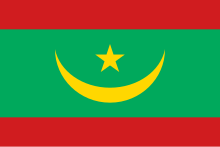History of Mauritania (1984–present)
In December 1984, Haidallah was deposed by Colonel Maaouya Ould Sid'Ahmed Taya, who, while retaining tight military control, relaxed the political climate.
[3] In October 1987, the military government allegedly uncovered a tentative coup d'État by a group of black army officers, backed, according to the authorities, by Senegal.
[5] They were accused of "endangering the security of the State by participating in a conspiracy to overthrow the government and to provoke killing and devastation among the inhabitants of the country" and tried following a special summary procedure.
[3] In the larger towns and cities, the authorities targeted black civil servants, employees of private institutions, trade unionists, former political prisoners.
[9] In October 1987, the Government allegedly uncovered a tentative coup d'état by a group of black army officers, backed, according to the authorities, by Senegal.
[11] Heightened ethnic tensions were the catalyst for the Mauritania–Senegal Border War, which started as a result of a conflict in Diawara between Moorish Mauritanian herders and Senegalese farmers over grazing rights.
[13] Following the incident, several riots erupted in Bakel, Dakar and other towns in Senegal, directed against the mainly Arabized Mauritanians who dominated the local retail business.
As low scale conflict with Senegal continued into 1990/91, the Mauritanian government engaged in or encouraged acts of violence and seizures of property directed against the Haalpularen ethnic group.
[2]: 27 From November 1990 to February 1991, between 200 and 500 (depending on the sources) Fula and Soninke soldiers and/or political prisoners were executed by Mauritanian governmental forces.
[20] Ould Taya also started co-operating with the United States in anti-terrorism activities, a policy that was criticized by some human rights organizations.
The Parti Républicain Démocratique et Social (PRDS), formerly led by President Maaouya Ould Sid'Ahmed Taya, dominated Mauritanian politics after the country's first multi-party elections in April 1992, following the approval by referendum of the current Constitution in July 1991.
On 28 October 1999, Mauritanian Foreign Minister Ahmed Ould Sid'Ahmed and his Israeli counterpart David Levy signed an agreement in Washington DC, USA, establishing full diplomatic relations between the two countries.
Ould Taya also started co-operating with the United States in anti-terrorism activities, a policy which was criticized by some human rights organizations, which claimed that Mauritania's problem with terrorism was being misrepresented for geopolitical purposes.
On June 8, 2003, a failed coup attempt was made against President Maaouya Ould Sid'Ahmed Taya by forces unhappy with his imprisonment of Islamic leaders in the wake of the US-led invasion of Iraq and his establishment of full diplomatic relations with Israel.
A number of government officials were detained after the coup including the head of the Supreme Court, Mahfoud Ould Lemrabott, and the Secretary of State for Women's Affairs, Mintata Mint Hedeid.
[29] On August 3, 2005, the Mauritanian military, including members of the Presidential guard (BASEP), seized control of key points in the capital of Nouakchott, performing a coup against the Government of President Maaouya Ould Sid'Ahmed Taya who was out of the country,[30] attending the funeral of Saudi King Fahd.
[32] On August 6, 2008, Mauritania's presidential spokesman Abdoulaye Mamadouba said President Sidi Ould Cheikh Abdallahi, Prime Minister Yahya Ould Ahmed Waghf and the Interior minister, were arrested by renegade Senior Mauritanian army officers, unknown troops and a group of generals, and were held under house arrest at the Presidential palace in Nouakchott.
[37] Mauritanian lawmaker, Mohammed Al Mukhtar, announced that "many of the country's people were supporting the takeover attempt and the government is "an authoritarian regime" and that the president had "marginalized the majority in parliament.
[40] Originally, the referendum was scheduled to take place on July 15, but was rescheduled to August 5 due to changes in the proposed constitutional amendments and protests.


